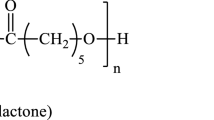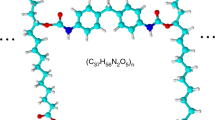Abstract
Castor oil was autoxidized for three months to obtain macroperoxide castor oil (PCO). Since this polymeric oil has peroxide groups and hydroxyl groups, free-radical polymerization (FRP), ring-opening polymerization, and one-pot polymerization both free-radical polymerization (FRP) and ring-opening polymerization in one step methods were used to synthesis of various types of the graft copolymers. PCO-g-Polystyrene, PCO-g-Poly(methyl acrylate), and PCO-g-Poly(tert-buytl acrylate) were synthesized using the free-radical polymerization method. PCO-g-Poly(ε-caprolactone) graft copolymer was obtained via ring-opening polymerization, and PCO-g-Polystyrene-g-Poly(ε-caprolactone) graft copolymer was obtained using one-pot polymerization method. All graft copolymers obtained were characterized by proton nuclear magnetic resonance (1H NMR), Fourier-transform infrared, differential scanning calorimetry, thermal gravimetric analysis, and elemental analysis. After the synthesis of castor oil-based copolymers, we determined the antimicrobial effects of them as well as the antiproliferative effects on breast cancer cell lines. Antimicrobial activity was carried out using the disc diffusion method and the dilution method. As a result of antimicrobial activity, the compounds showed moderate antimicrobial effects on microorganisms compared to standard antibiotics. In particular, the compounds have shown more antibacterial activity than antifungal activity. We also observed a prominent antiproliferative effect of synthesized compounds depending on increasing doses (1–25 µg/mL) and times (24–48 h) in MDA-MB-231 breast cancer cells.









Similar content being viewed by others
References
Meier MAR, Metzger JO, Schubert US (2007) Plant oil renewable resources as green alternatives in polymer science. Chem Soc Rev 36(11):1788–1802. https://doi.org/10.1039/b703294c
Seniha Güner F, Yaǧci Y, Tuncer Erciyes A (2006) Polymers from triglyceride oils. Prog Polym Sci 31(7):633–670. https://doi.org/10.1016/j.progpolymsci.2006.07.001
Keleş E, Hazer B (2009) Synthesis of segmented polyurethane based on polymeric soybean oil polyol and poly (ethylene glycol). J Polym Environ 17(3):153–158. https://doi.org/10.1007/s10924-009-0132-0
Çakmakli B, Hazer B, Tekin IÖ, Cömert FB (2005) Synthesis and characterization of polymeric soybean oil-g-methyl methacrylate (and n-butyl methacrylate) graft copolymers: biocompatibility and bacterial adhesion. Biomacromolecules 6(3):1750–1758. https://doi.org/10.1021/bm050063f
Koc H, Kilicay E, Karahaliloglu Z, Hazer B, Denkbas EB (2021) Prevention of urinary infection through the incorporation of silver-ricinoleic acid-polystyrene nanoparticles on the catheter surface. J Biomater Appl. https://doi.org/10.1177/0885328220983552
Hazer B, Ayyıldız E, Eren M, Seçilmiş Canbay H, Ashby RD (2019) Autoxidized oleic acid bifunctional macro peroxide initiators for free radical and condensation polymerization. Synthesis and characterization of multiblock copolymers. J Polym Environ 27(11):2562–2576. https://doi.org/10.1007/s10924-019-01536-6
Alli A, Hazer B (2008) Poly(N-isopropylacrylamide) thermoresponsive cross-linked conjugates containing polymeric soybean oil and/or polypropylene glycol. Eur Polym J 44(6):1701–1713. https://doi.org/10.1016/j.eurpolymj.2008.04.004
Alli A, Alli S, Becer CR, Hazer B (2014) One-pot synthesis of poly(linoleic acid)-g-poly(styrene)-g-poly(ε- caprolactone) graft copolymers. J Am Oil Chem Soc 91(5):849–858. https://doi.org/10.1007/s11746-014-2418-1
Allı A, Arı Y, Gökçen M (2016) Novel poly(linolenic acid) graft copolymers: synthesis, characterization and electrical properties. J Am Oil Chem Soc 93(7):895–904. https://doi.org/10.1007/s11746-016-2834-5
Alli S, Tigli Aydin RS, Alli A, Hazer B (2015) Biodegradable poly(ε-caprolactone)- based graft copolymers via poly(linoleic acid): in vitro enzymatic evaluation. J Am Oil Chem Soc 92(3):449–458. https://doi.org/10.1007/s11746-015-2611-x
Alli A, Alli S, Becer CR, Hazer B (2016) Nitroxide-mediated copolymerization of styrene and pentafluorostyrene initiated by polymeric linoleic acid. Eur J Lipid Sci Technol 118(2):279–287. https://doi.org/10.1002/ejlt.201500129
Ogunniyi DS (2006) Castor oil: a vital industrial raw material. Bioresour Technol 97(9):1086–1091. https://doi.org/10.1016/j.biortech.2005.03.028
Kunduru KR, Basu A, Haim Zada M, Domb AJ (2015) Castor oil-based biodegradable polyesters. Biomacromolecules 16(9):2572–2587. https://doi.org/10.1021/acs.biomac.5b00923
da Silva N de L, Maciel MRW, Batistella CB, Maciel Filho R (2006) Optimization of biodiesel production from castor oil. Appl Biochem Biotechnol 130:405-414. https://doi.org/10.1385/abab:130:1:405
Jia P, Zhang M, Hu L, Feng G, Bo C, Zhou Y (2015) Synthesis and application of environmental castor oil based polyol ester plasticizers for poly(vinyl chloride). ACS Sustain Chem Eng 3(9):2187–2193. https://doi.org/10.1021/acssuschemeng.5b00449
Geethanjali G, Padmaja KV, Prasad RBN (2016) Synthesis, characterization, and evaluation of castor oil-based acylated derivatives as potential lubricant base stocks. Ind Eng Chem Res 55(34):9109–9117. https://doi.org/10.1021/acs.iecr.6b01550
Bray F, Ferlay J, Soerjomataram I, Siegel RL, Torre LA, Jemal A (2018) Global cancer statistics 2018: globocan estimates of incidence and mortality worldwide for 36 cancers in 185 countries. CA Cancer J Clin 68(6):394–424. https://doi.org/10.3322/caac.21492
Azamjah N, Soltan-Zadeh Y, Zayeri F (2019) Global trend of breast cancer mortality rate: A 25-year study. Asian Pacific J Cancer Prev. 20(7):2015–2020. https://doi.org/10.31557/APJCP.2019.20.7.2015
World Health Organization (2021) Breast cancer. URL:http://www.who.int/news-room/fact sheets/detail/breast-cancer.
Richie RC, Swanson JO (2003) Breast cancer: a review of the literature. J Insur Med 35(2):85–101 (PMID: 14733031)
Kizaloglu A, Kilicay E, Karahaliloglu Z, Hazer B, Denkbas EB (2020) The preparation of chitosan membrane improved with nanoparticles based on unsaturated fatty acid for using in cancer-related infections. J Bioact Compat Polym 35(4–5):328–350. https://doi.org/10.1177/0883911520943222
Karahaliloğlu Z, Kilicay E, Alpaslan P, Hazer B, Denkbas EB (2018) Enhanced antitumor activity of epigallocatechin gallate-conjugated dual-drug-loaded polystyrene-polysoyaoil-diethanol amine nanoparticles for breast cancer therapy. J Bioact Compat Polym 33(1):38–62. https://doi.org/10.1177/0883911517710811
Greenwell M, Rahman PKS (2015) Europe PMC funders group medicinal plants : their use In anticancer treatment. Int J Pharm Sci Res 6(10):4103–4112. https://doi.org/10.13040/IJPSR.0975-8232.6(10).4103-12.Medicinal
Zarai Z, Ben CI, Ben MR, Békir A, Gharsallah N, Kadri A (2012) Essential oil of the leaves of Ricinus communis L.: In vitro cytotoxicity and antimicrobial properties. Lipids Health Dis 11:1–7. https://doi.org/10.1186/1476-511X-11-102
Ilavarasan R, Mallika M, Venkataraman S (2006) Anti-inflammatory and free radical scavenging activity of Ricinus communis root extract. J Ethnopharmacol 103(3):478–480. https://doi.org/10.1016/j.jep.2005.07.029
Kadri A, Gharsallah N, Damak M, Gdoura R (2011) Chemical composition and in vitro antioxidant properties of essential oil of ricinus communis L. J Med Plants Res 5(8):1466–1470. https://doi.org/10.5897/JMPR.9000347
Prakash E, Gupta DK (2014) In Vitro study of extracts of ricinus communis linn on human cancer Cell Lines. Med Sci Public Health 2(1):15–20
CLSI (Clinical and Laboratory Standards Institue) (2002) Methods for dilution antimicrobial susceptibility tests bacteria that grow aerobically. 3rd edition approved standard. NCCLS document M100-S12, Wayne, PA, USA.
Zgoda J, Porter JA (2001) Convenient microdilution method for screening natural products against bacteria and fungi. Pharm Biol 39:221–225. https://doi.org/10.1076/phbi.39.3.221.5934
Jones RN, Barry AL, Gaven TL, Washington JA (1984). In: Lennette EH, Balows A, Shadomy WJ (eds) Manual of clinical microbiology, 4th edn. American Society for Microbiology, Washington DC, pp 972–977
Mabasa R, Malemela K, Serala K, Kgakishe M, Matsebatlela T, Mokgotho M, Mbazima V (2021) Ricinus communis butanol fraction ınhibits MCF-7 breast cancer cell migration, adhesion, and ınvasiveness. Integr Cancer Ther 20:1–11. https://doi.org/10.1177/1534735420977684
Majumder M, Debnath S, Gajbhiye R, Saikia R, Gogoi B, Samanta SK, Das DK, Biswas K, Jaisankar P, Mukhopadhyay R (2019) Ricinus communis L. fruit extract inhibits migration/invasion, induces apoptosis in breast cancer cells and arrests tumor progression in vivo. Sci Rep 9(1):1–14. https://doi.org/10.1038/s41598-019-50769-x
Acknowledgements
This work was supported by the Duzce University Research Funds (2020.05.03.1134, 2020.05.03.1135, 2021.05.03.1176)
Author information
Authors and Affiliations
Corresponding author
Ethics declarations
Conflict of interest
No potential conflict of interest was reported by the authors.
Additional information
Publisher's Note
Springer Nature remains neutral with regard to jurisdictional claims in published maps and institutional affiliations.
Rights and permissions
About this article
Cite this article
Alli, S., Dulger, G., Kiliccioglu, I. et al. Castor oil—based graft copolymers: synthesis, characterization antimicrobial activity and antiproliferative effects against breast cancer cell lines. Polym. Bull. 79, 11177–11199 (2022). https://doi.org/10.1007/s00289-021-03908-2
Received:
Revised:
Accepted:
Published:
Issue Date:
DOI: https://doi.org/10.1007/s00289-021-03908-2




